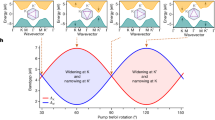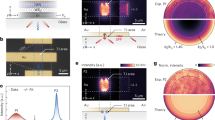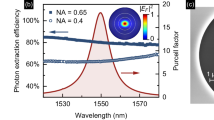Abstract
Photochemical upconversion is a strategy for converting infrared light into more energetic, visible light, with potential applications ranging from biological imaging and drug delivery to photovoltaics and photocatalysis. Although systems have been developed for upconverting light from photon energies in the near-infrared, upconversion from below the silicon bandgap has been out of reach. Here, we demonstrate an upconversion composition using PbS semiconductor nanocrystal sensitizers that absorb photons below the bandgap of silicon and populate violanthrone triplet states below the singlet oxygen energy. The triplet-state violanthrone chromophores luminesce in the visible spectrum following energy delivery from two singlet oxygen molecules. By incorporating organic chromophores as ligands onto the PbS nanocrystals to improve energy transfer, we demonstrate that violanthrone upconverts in the absence of oxygen by the triplet–triplet annihilation mechanism. The change in mechanism is shown by exploiting the magnetic field effect on triplet–triplet interactions.
This is a preview of subscription content, access via your institution
Access options
Access Nature and 54 other Nature Portfolio journals
Get Nature+, our best-value online-access subscription
$29.99 / 30 days
cancel any time
Subscribe to this journal
Receive 12 print issues and online access
$209.00 per year
only $17.42 per issue
Buy this article
- Purchase on Springer Link
- Instant access to full article PDF
Prices may be subject to local taxes which are calculated during checkout





Similar content being viewed by others
Data availability
The data that support the findings of this study are available from the corresponding author on reasonable request.
References
Ravetz, B. D. et al. Photoredox catalysis using infrared light via triplet fusion upconversion. Nature 565, 343–346 (2019).
Khnayzer, R. S. et al. Upconversion-powered photoelectrochemistry. Chem. Commun. 48, 209–211 (2012).
Schulze, T. F. & Schmidt, T. W. Photochemical upconversion: present status and prospects for its application to solar energy conversion. Energy Environ. Sci. 8, 103–125 (2015).
Cheng, Y. Y. et al. Improving the light-harvesting of amorphous silicon solar cells with photochemical upconversion. Energy Environ. Sci. 5, 6953–6959 (2012).
Park, Y. I., Lee, K. T., Suh, Y. D. & Hyeon, T. Upconverting nanoparticles: a versatile platform for wide-field two-photon microscopy and multi-modal in vivo imaging. Chem. Soc. Rev. 44, 1302–1317 (2015).
Wen, S. et al. Future and challenges for hybrid upconversion nanosystems. Nat. Photon. 13, 828–838 (2019).
Schmidt, T. W. & Castellano, F. N. Photochemical upconversion: the primacy of kinetics. J. Phys. Chem. Lett. 5, 4062–4072 (2014).
Pedrini, J. & Monguzzi, A. Recent advances in the application triplet–triplet annihilation-based photon upconversion systems to solar technologies. J. Photon. Ener. 8, 8–16 (2017).
Mongin, C., Garakyaraghi, S., Razgoniaeva, N., Zamkov, M. & Castellano, F. N. Direct observation of triplet energy transfer from semiconductor nanocrystals. Science 351, 369–372 (2016).
Huang, Z. et al. Hybrid molecule-nanocrystal photon upconversion across the visible and near-infrared. Nano Lett. 15, 5552–5557 (2015).
Wu, M. et al. Solid-state infrared-to-visible upconversion sensitized by colloidal nanocrystals. Nat. Photon. 10, 31–34 (2016).
Huang, Z. & Lee Tang, M. Semiconductor nanocrystal light absorbers for photon upconversion. J. Phys. Chem. Lett. 9, 6198–6206 (2018).
Nienhaus, L., Wu, M., Bulović, V., Baldo, M. A. & Bawendi, M. G. Using lead chalcogenide nanocrystals as spin mixers: a perspective on near-infrared-to-visible upconversion. Dalton Trans. 47, 8509–8516 (2018).
Garakyaraghi, S., Mongin, C., Granger, D. B., Anthony, J. E. & Castellano, F. N. Delayed molecular triplet generation from energized lead sulfide quantum dots. J. Phys. Chem. Lett. 8, 1458–1463 (2017).
Mongin, C., Moroz, P., Zamkov, M. & Castellano, F. N. Thermally activated delayed photoluminescence from pyrenyl-functionalized CdSe quantum dots. Nat. Chem. 10, 225–230 (2018).
Kroupa, D. M. et al. Control of energy flow dynamics between tetracene ligands and PbS quantum dots by size tuning and ligand coverage. Nano Lett. 18, 865–873 (2018).
Nishimura, N. et al. Photon upconversion utilizing energy beyond the band gap of crystalline silicon with a hybrid TES-ADT/PbS quantum dots system. Chem. Sci. 10, 4750–4760 (2019).
Askes, S. H. C. & Bonnet, S. Solving the oxygen sensitivity of sensitized photon upconversion in life science applications. Nat. Rev. Chem. 2, 437–452 (2018).
Baluschev, S., Katta, K., Avlasevich, Y. & Landfester, K. Annihilation upconversion in nanoconfinement: solving the oxygen quenching problem. Mater. Horiz. 3, 478–486 (2016).
Svagan, A. J. et al. Photon energy upconverting nanopaper: a bioinspired oxygen protection strategy. ACS Nano 8, 8198–8207 (2014).
Kang, J.-H. & Reichmanis, E. Low-threshold photon upconversion capsules obtained by photoinduced interfacial polymerization. Angew. Chem. Int. Ed. 51, 11841–11844 (2012).
Fückel, B. et al. Singlet oxygen mediated photochemical upconversion of NIR light. J. Phys. Chem. Lett. 2, 966–971 (2011).
Ogryzlo, E. A. & Pearson, A. E. Excitation of violanthrone by singlet oxygen. a chemiluminescence mechanism. J. Phys. Chem. 72, 2913–2916 (1968).
Trupke, T., Green, M. A. & Würfel, P. Improving solar cell efficiencies by up-conversion of sub-band-gap light. J. Appl. Phys. 92, 4117–4122 (2002).
Saritaş, M. & McKell, H. D. Absorption coefficient of Si in the wavelength region between 0.80–1.16 μm. J. Appl. Phys. 61, 4923–4925 (1987).
Engel, T. & Reid, P. Physical Chemistry 3rd edn, Ch. 35, 997 (Pearson Education, 2013).
Samia, A. C. S., Chen, X. & Burda, C. Semiconductor quantum dots for photodynamic therapy. J. Am. Chem. Soc. 125, 15736–15737 (2003).
Stern, H. L. et al. Identification of a triplet pair intermediate in singlet exciton fission in solution. Proc. Natl Acad. Sci. USA 112, 7656–7661 (2015).
Matsui, Y. et al. Exergonic intramolecular singlet fission of an adamantane-linked tetracene dyad via twin quintet multiexcitons. J. Phys. Chem. C 123, 18813–18823 (2019).
Merrifield, R. E. Theory of magnetic field effects on the mutual annihilation of triplet excitons. J. Chem. Phys. 48, 4318–4319 (1968).
Atkins, P. & Evans, G. Magnetic field effects on chemiluminescent fluid solutions. Mol. Phys. 29, 921–935 (1975).
Iwasaki, Y., Maeda, K. & Murai, H. Time-domain observation of external magnetic field effects on the delayed fluorescence of N,N,N',N'-tetramethyl-1,4-phenylenediamine in alcoholic solution. J. Phys. Chem. A 105, 2961–2966 (2001).
Monroe, B. M. photochemical estimation of oxygen solubility. Photochem. Photobiol. 35, 863–865 (1982).
Zamani-Khamiri, O. & Hameka, H. Spin-orbit contribution to the zero-field splitting of the oxygen molecule. J. Chem. Phys. 55, 2191–2197 (1971).
Frazer, L., Gallaher, J. K. & Schmidt, T. W. Optimizing the efficiency of solar photon upconversion. ACS Energy Lett. 2, 1346–1354 (2017).
Schulze, T. F. et al. Photochemical upconversion enhanced solar cells: effect of a back reflector. Aust. J. Chem. 65, 480–485 (2012).
Stanley, C. P. et al. Singlet molecular oxygen regulates vascular tone and blood pressure in inflammation. Nature 566, 548–552 (2019).
Kakuichi, M., Kasatani, K. & Morita, Y. Preparation of nanoparticles of a violanthrone derivative with properties of J-like aggregates. Trans. Mater. Res. Soc. Jpn. 37, 471–474 (2012).
Dover, C. B. et al. Endothermic singlet fission is hindered by excimer formation. Nat. Chem. 10, 305–310 (2018).
Hu, L. et al. Graphene doping improved device performance of ZnMgO/PbS colloidal quantum dot photovoltaics. Adv. Funct. Mater. 26, 1899–1907 (2016).
Beygi, H., Sajjadi, S. A., Babakhani, A., Young, J. F. & van Veggel, F. C. J. M. Surface chemistry of as-synthesized and air-oxidized PbS quantum dots. Appl. Surf. Sci. 457, 1–10 (2018).
Acknowledgements
This work was supported by the Australian Research Council (Centre of Excellence in Exciton Science CE170100026). The research used facilities supported by Microscopy Australia at the Electron Microscope Unit (EMU) and the Solid State and Elemental Analysis Unit within the Mark Wainwright Analytical Centre (MWAC) at UNSW Sydney.
Author information
Authors and Affiliations
Contributions
E.M.G., S.K.K.P., S.N. and T.I. performed the optical measurements and analysed the data. S.H. and Z.L.T. synthesized the PbS material. J.E.A. and A.J.P. synthesized the TTCA ligands. J.H.C. performed theoretical analysis of the magnetic field effects. S.C. and R.D.T. performed the TEM measurements. T.W.S. conceived the experiments and wrote the manuscript.
Corresponding author
Ethics declarations
Competing interests
The authors declare no competing interests.
Additional information
Publisher’s note Springer Nature remains neutral with regard to jurisdictional claims in published maps and institutional affiliations.
Supplementary information
Supplementary Information
Supplementary Figs. 1–9, Tables 1–3 and text.
Rights and permissions
About this article
Cite this article
Gholizadeh, E.M., Prasad, S.K.K., Teh, Z.L. et al. Photochemical upconversion of near-infrared light from below the silicon bandgap. Nat. Photonics 14, 585–590 (2020). https://doi.org/10.1038/s41566-020-0664-3
Received:
Accepted:
Published:
Issue Date:
DOI: https://doi.org/10.1038/s41566-020-0664-3
This article is cited by
-
Near-infrared photon upconversion and solar synthesis using lead-free nanocrystals
Nature Photonics (2023)
-
Towards highly efficient NIR II response up-conversion phosphor enabled by long lifetimes of Er3+
Nature Communications (2022)
-
Simple preparation of a CuO@γ-Al2O3 Fenton-like catalyst and its photocatalytic degradation function
Environmental Science and Pollution Research (2022)
-
Strategies to improve light utilization in solar fuel synthesis
Nature Energy (2021)
-
Untapping solar energy resources
Nature Photonics (2020)



